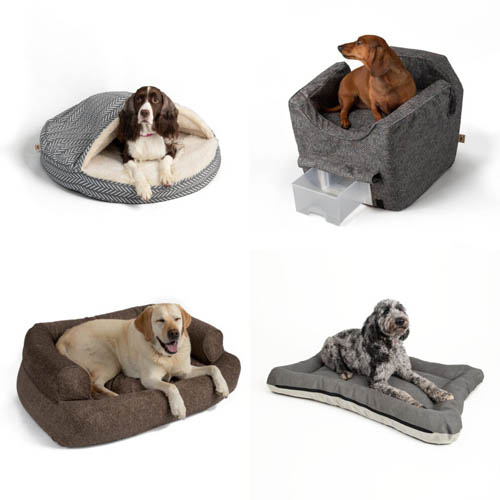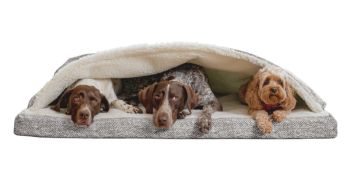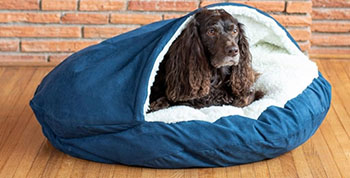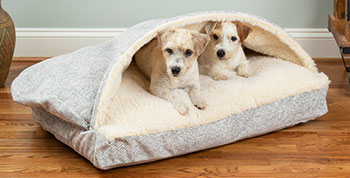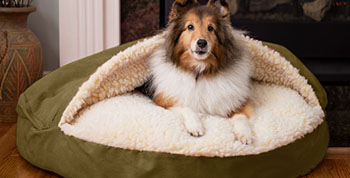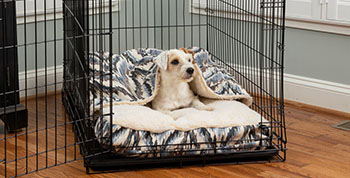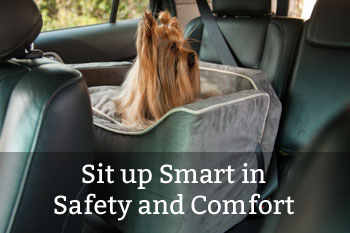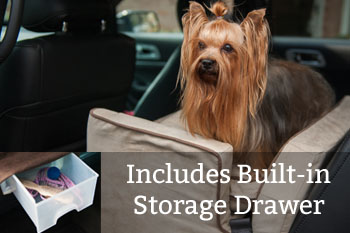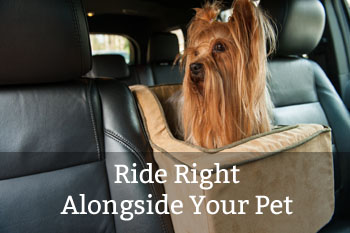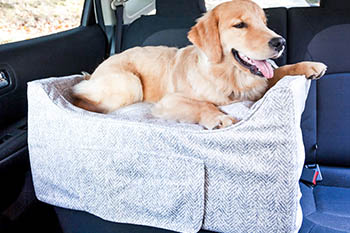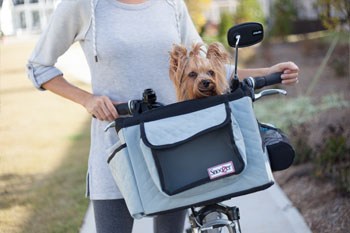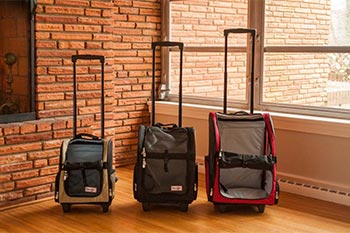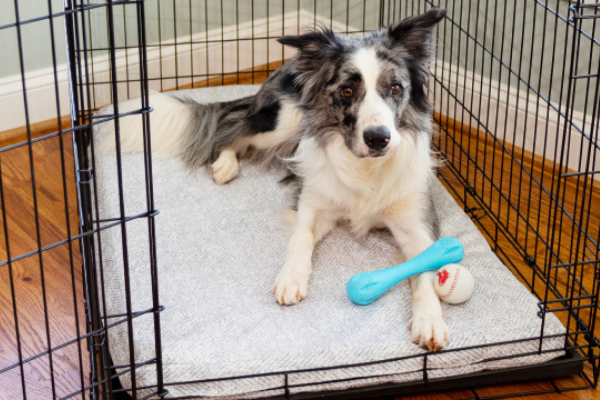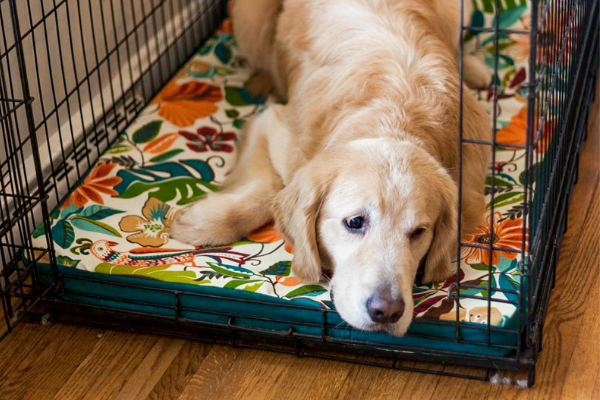How to Crate Train a Puppy
Crate training a puppy can seem like a very daunting task at first. How do you take an energetic new puppy, who’s still getting used to life in a new home, and get them to go into their crate – happily – at your command?
Never fear; it can be done! The steps themselves are simple enough. It just requires patience and consistency on your part to ensure success.
If you’ve ever wondered about how to crate train your puppy, read on!
Why Crate Train a Puppy?
There are many good reasons to crate train your puppy. One is that the crate is a safe, secure place for your puppy or dog can to be in when you can’t supervise them. This is useful for all ages, but especially for puppies and younger dogs who haven’t yet learned the rules of the house (like, no digging through the trash or tearing up the couch when left alone).
The crate can be used to separate your dog from other pets or people when necessary, say when you have a visitor who is afraid of or allergic to dogs, or young children who don’t know how to behave safely around dogs.
Crate training also helps with house training. Dogs don’t like to soil the area they live in, and by staying in their crate, they can learn to hold it and communicate to you when they need to go outside.
Crate training is also handy for traveling. If your dog’s crate fits, it can be put in the car for trips, providing a safer car ride for all passengers.
Plus, your puppy will soon understand that their crate is their special place. Many dogs like to have a little “den” of their own to retreat to when they want to rest or have some quiet time.
How long does it take to crate train a puppy?
The length of time it takes for your puppy to be crate trained depends on you and the puppy. As the owner/trainer, it’s up to you to be consistent throughout the training process and not give up just because you’re tired and tempted to throw in the towel. The more consistent you are, the faster the process will be. In general, you’re looking at a matter of days or a few weeks.
As for your puppy, you may have an obedient dog who’s eager to please, or a headstrong pup who wants to do their own thing. Don’t give up! With consistent practice, you can succeed at crate training.
How to crate train a puppy?
The general philosophy behind crate training a puppy – or training any behavior, really – is to take it step by step. You’ll gradually shape behaviors over time until you get the target behavior you want
Step 1: Making Friends
Before you start any formal training, allow your puppy to get used to the crate on their own terms. Leave the door open so your dog can wander in and out if they want, but don’t push them to. At this stage, all you want is for your puppy to get to know this unfamiliar object and to understand they don’t have to be afraid of it.
Step 2: Taking Puppy Steps
Once your puppy has “made friends” with their crate, now you want to actively encourage your dog to get inside the crate – slowly. Use special treats your dog is totally crazy for, like bacon or hamburger pieces, to shape their behavior. When your puppy puts a paw in or pokes their head inside, toss a treat in to reward the behavior. The goal is to get your puppy going fully inside the crate, but do it in steps. And don’t give treats after they leave the crate while you’re crate training. These treats are only available in the crate!
Step 3: Shaping Sitting and Laying Down
Once your puppy is good at getting inside the crate, it’s time to work on getting your puppy to sit and then lie down inside. If you’ve already trained commands like “sit” and “down,” this will help, but it’s not necessary. Reward your puppy each time they sit down or lie down in the crate.
Step 4: Lengthening Time in the Crate
Your puppy now needs to get used to spending time in their crate. Reward your puppy for spending longer amounts of time in the crate, working up from a few seconds to a full minute. When your puppy has been in there as long as you want, reward with verbal praise, and from here on out give treats only sometimes. This type of intermittent reinforcement schedule is very powerful in shaping behaviors.
Feeding meals in the crate is a good way to get your dog motivated to go into the crate and spend time in there. They will also associate it with something positive – food!
Step 5: Closing the Door
If your puppy’s at the stage where they can stay in the crate for a minute at a time, it’s time to get them used to the door being closed (but not latched). Start by having them go in and then close the door, but open it right after. Then continue to practice staying in the crate for longer periods of time with the door closed. Try 1 second, 5 seconds, 10, 20, and so on, working your way up. Reinforce with verbal praise and the occasional treat.
Step 6: Staying Alone
Finally, your puppy needs to get used to being in the crate without you nearby. As before, praise your puppy when they go inside and lie down. Close the door. Now stand a few steps back from the crate. Lengthen the distance you stand from the crate, then lengthen the amount of time you’re away from the crate. As with the previous steps above, use verbal praise to reinforce your dog’s behavior and give the occasional treat, too.
There you have it, that’s how to properly crate train a puppy. It may not be a piece of cake, but it’s well worth it!
Make Your Puppy’s Crate Their Favorite “Spot”
To make your puppy’s crate even more appealing, add a crate pad or crate cover. Your dog will love spending time in their comfy and cozy crate!
Crate Pads for Dogs
Crate pads are a great addition to any dog’s crate, especially once your puppy is crate trained, and can add a high level of comfort for dogs, especially those who are more prone to developing arthritis. At Snoozer we offer a wonderful selection of crate covers and crate pads. Our top selling crate pads both have machine-washable covers and are available in two models.
- The “Forgiveness” washable mattress crate pad: for dogs who tend to struggle with incontinence and peeing on their beds, this crate pad is perfect. Remove and wash the machine-washable outside cover, then rinse and wash the mattress to keep your pet’s environment free from bacteria and your home smelling fresh.
- The “Outlast” cooling crate pad with temperature regulating technology: for dogs who tend to struggle with getting overheated, this dog crate pad is made with temperature regulating technology to keep them cool in the warmer months, while also preventing pups from getting too cold in the winter months – helping to keep every dog’s temperature “just right”.
Crate Covers for Dogs
Crate covers can add an extra layer of security to a dog’s crate, especially for dogs who are more anxious and need an additional support to provide them with optimal comfort & security.
Our crate covers are made using upholstery-grade fabrics, so you can keep your dog feeling secure while outfitting your dog crate to match your home’s interior style!
Our crate covers come in two beautiful fabric lines:
- Standard solid colors & camo prints dog crate covers
- WAG fabric line of bold & vibrant dog crate covers
We wish you the best of luck with all of your puppy crate training endeavors to come! If you need additional assistance finding the perfect dog crate pad or crate cover, get in touch with one of our dog experts at Snoozer Pet Products!
Much love,
Maple

